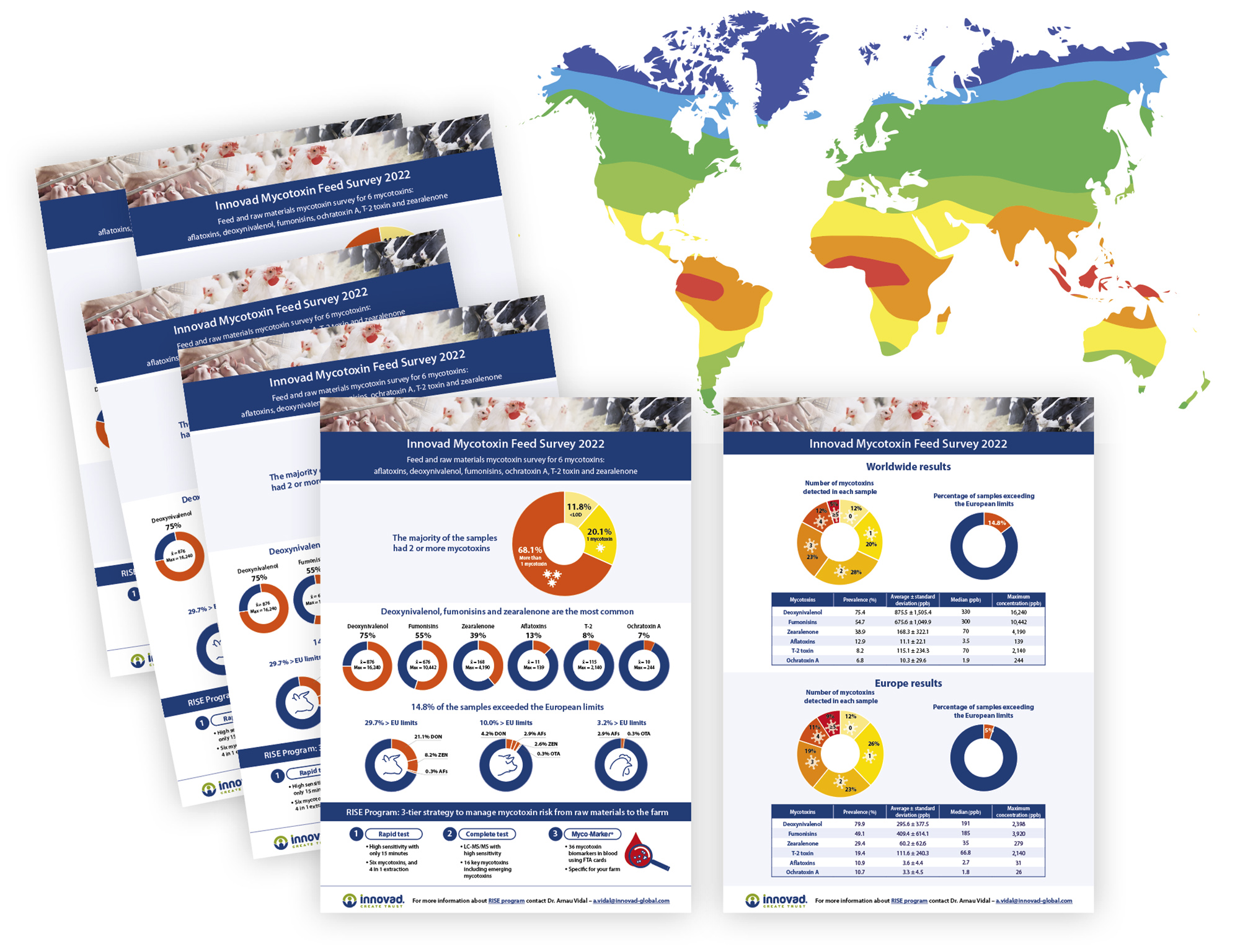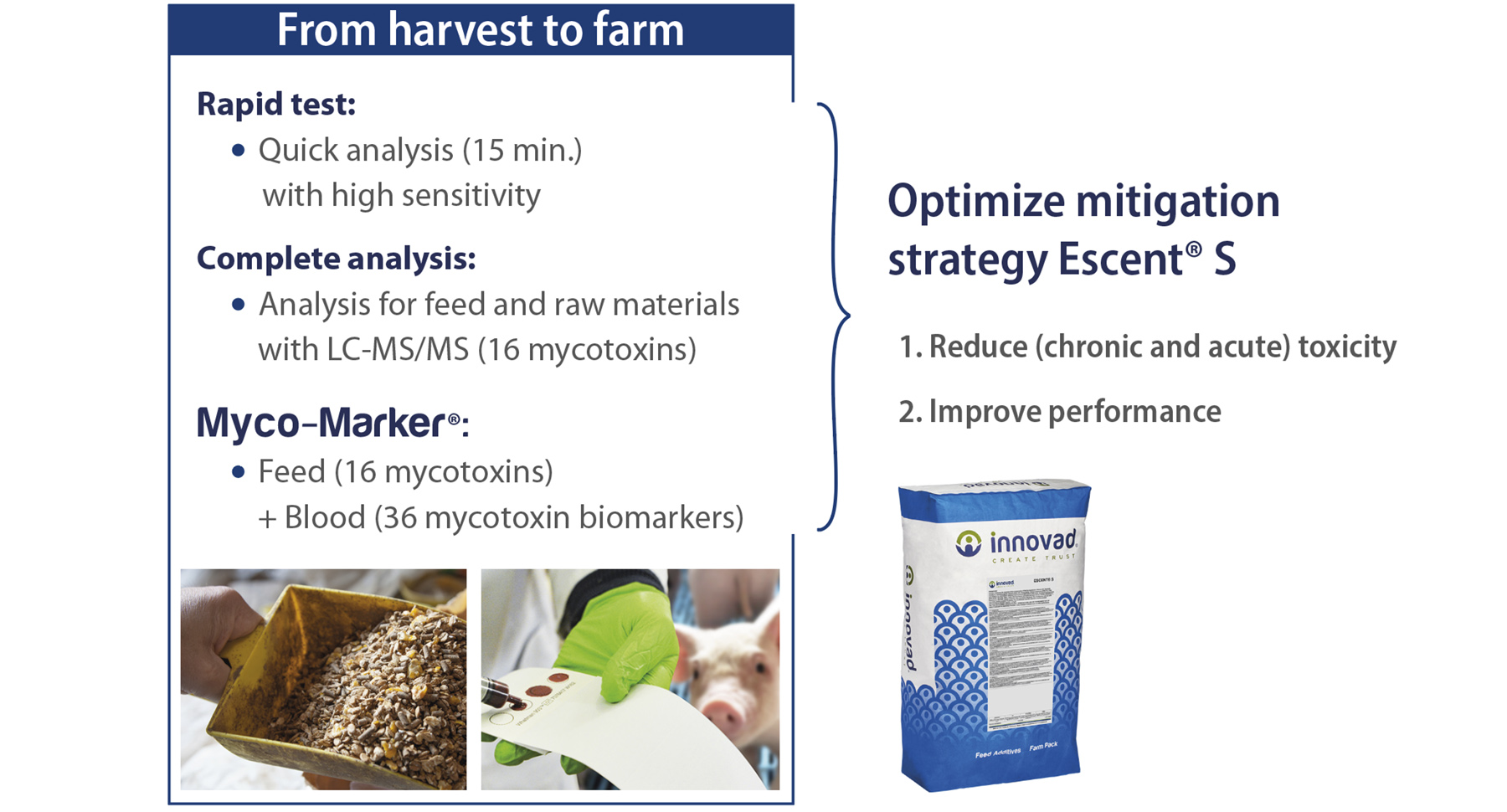Mycotoxins produced by fungi contaminate a wide variety of feed ingredients and cause a significant economically negative impact by affecting health status and reducing performance, welfare and profitability of livestock. As part of our stress control platform, Innovad offers our customers the possibility to monitor the mycotoxin risk in raw materials and feed. Through this program during 2022 we received samples from twenty-four different countries (42% America; 39% Europe; 14% Asia; 5% MEA) that were analysed using rapid test or LC-MS/MS, both at high sensitivity level.
The results of these analyses help us to extract important conclusions about mycotoxins threat levels for the six main mycotoxins (deoxynivalenol, aflatoxins, fumonisins, zearalenone, ochratoxin A and T-2) in feed and feed ingredients from the different geographical regions across the globe.
Co-exposure is the highly prevalent
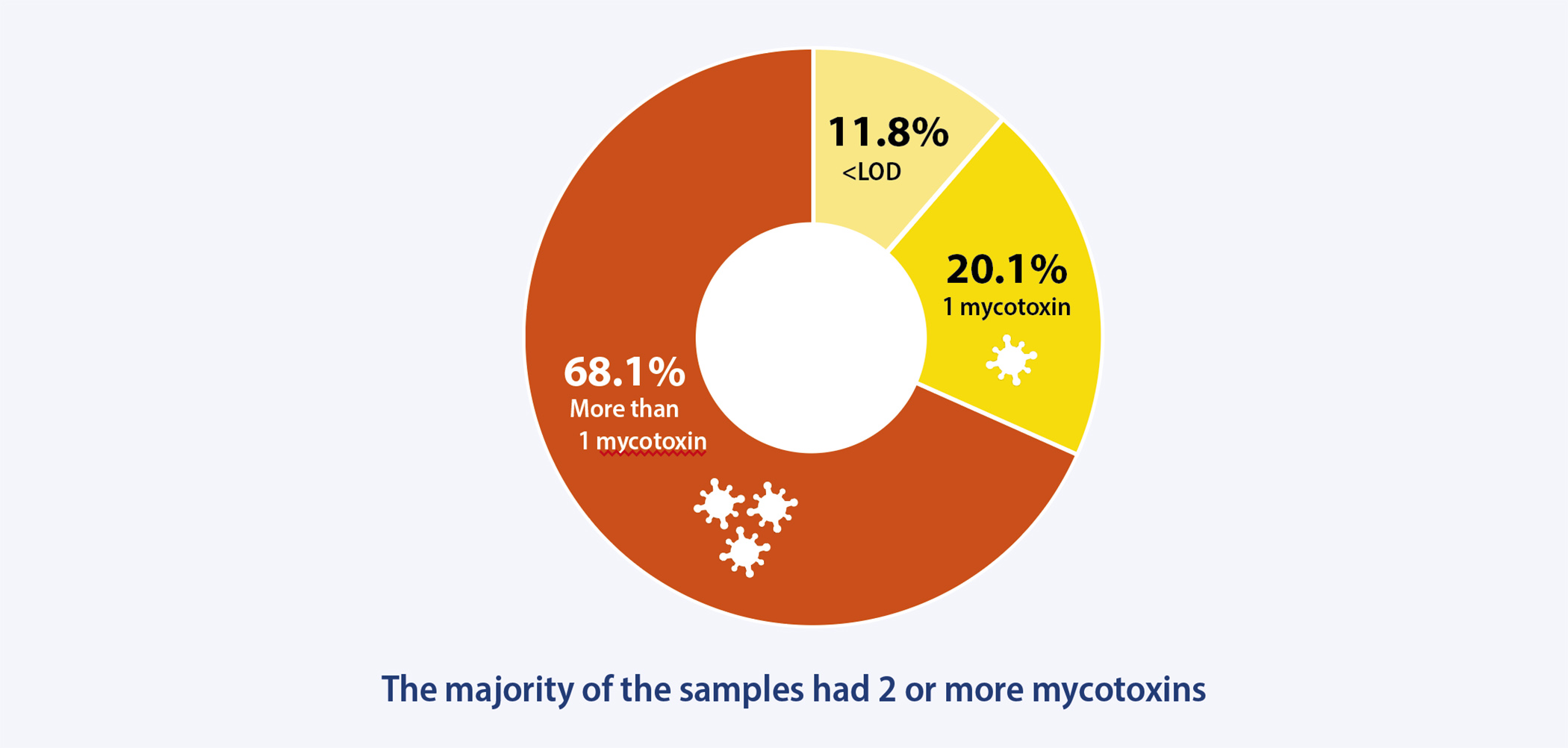
Results confirm that animals are continuously exposed to mycotoxins as most of the analysed samples (88.2%) were contaminated with one or more mycotoxins. Not unexpectedly, deoxynivalenol was the most frequent mycotoxin detected in feed ingredients (75.4%), followed by fumonisins (54.7%) and zearalenone (38.9%) (Table 1). To a significantly lesser extent, aflatoxins (12.9%), T-2 toxin (8.2%) and ochratoxin A (6.8%) were identified. It is important to note that, most of the samples were co-contaminated with two or more mycotoxins (68.1%). Combinations of two, three, four, five and six different mycotoxins were detected in 27.8, 23.3, 12.2, 3.6 and 1.2% respectively. Combinations of deoxynivalenol with fumonisins and zearalenone was most commonly found which is unsurprising considering all three produced by the same fungi, Fusarium. The large co-presence detected in the feed ingredients is of concern as their combined toxic effect is often synergistic or additive causing a greater impact than the individual mycotoxin effects.

High concentrations across all feeds
Many scientific studies demonstrate that chronic exposure (even at low levels) has an enormous impact on animal health status and performance. Low concentrations predispose animals to other infections, reduce growth and increase the FCR, whilst high mycotoxin levels cause acute toxicity in the animals with many severe clinical symptoms. This highlights the need to have programs in place that efficiently detect high mycotoxin concentration as a crucial as a first step to protect animals’ welfare. As part of the Innovad mycotoxin management plan established by Innovad we can rapidly identify samples that pose a high risk. This top level of detection gives producers the possibility to anticipate the problems and plan for the consequences. In this way we were able to detect that 14.8% of the samples (29.7% from ruminants, 10.0% from swine and 3.2% from poultry) had higher levels than the limits established by European Commission (EC)* with samples exceeding limits across mycotoxins and species. In poultry this was mainly caused by aflatoxins (2.9%) and ochratoxin A (0.3%), whilst deoxynivalenol (4.2%), aflatoxins (2.9%), zearalenone (2.6%) and ochratoxin A (0.3%) were common in swine, and deoxynivalenol (21.2%), zearalenone (8.2%) and T-2 (0.3%) in ruminants (Table 2).
*(2002/32/EC – aflatoxins; 2006/576/EC – deoxynivalenol, fumonisins, ochratoxin A, T-2 toxin and zearalenone; 2013/165/EC – T-2 toxin)
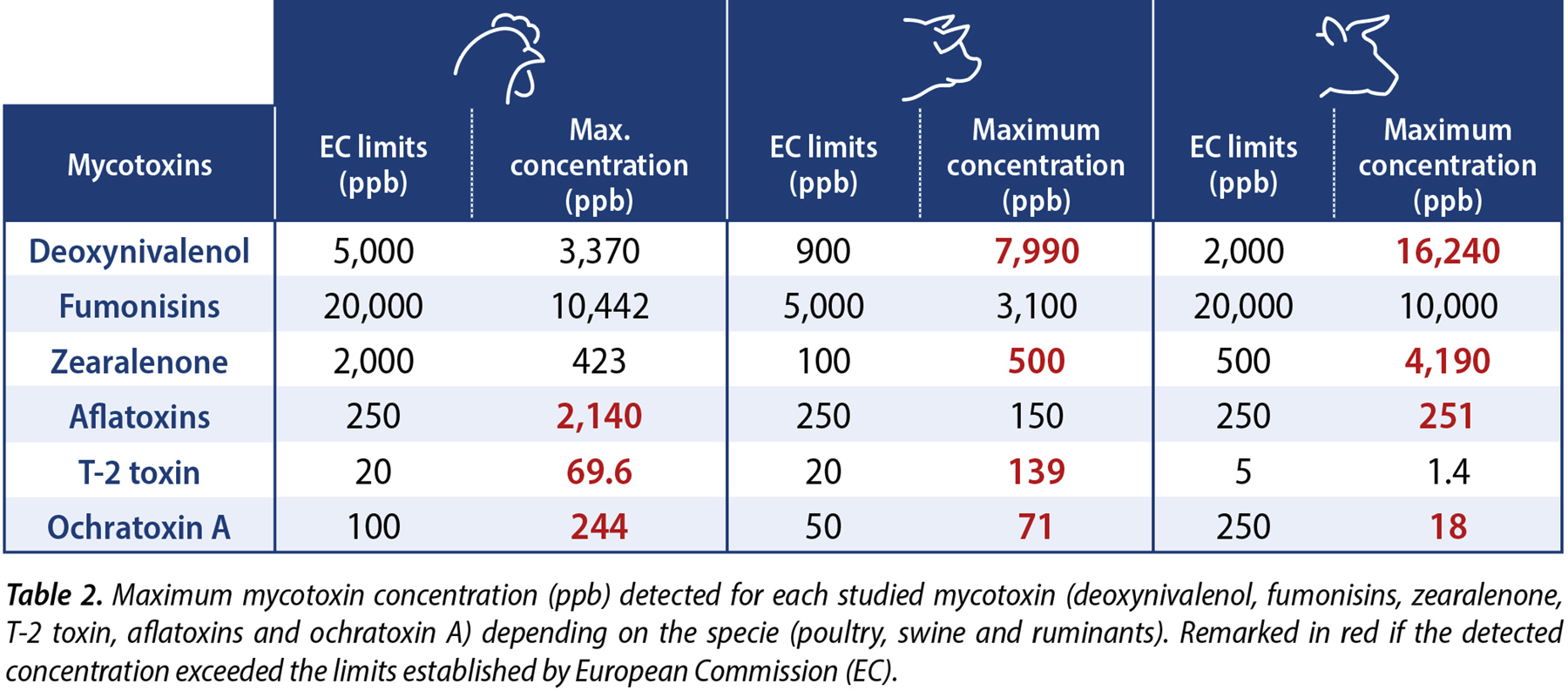
Geographical remarks
Interestingly, North America was the region with the highest percentage of samples that exceeded the limits. In total, 37% of the samples tested exceeded the limits of the European Commission, with deoxynivalenol and zearalenone being the most frequent mycotoxins overreaching the limit. In fact, the samples with the highest concentrations of deoxynivalenol and zearalenone were from North America (Table 3 and 4).


On the other hand, Europe was the region with the highest percentage of co-presence. Thus, 20% of the European samples had 4 or more mycotoxins at the same time. This is in line with our expectations as mycotoxins prevalence had increased in Europe during the second half of 2022. Thus, for the first time, aflatoxin was detected more repeatedly in samples from Europe (10.9%) than in Africa (9.6%).
All round mycotoxin control management system
Innovad offers a unique mycotoxin control strategy to manage mycotoxin risk from raw materials to the farm applying a 3-tier strategy:
- Rapid test:
- Results provided in few minutes: ideal for control of raw materials at reception points. The test offered by Innovad reduces time-to-results, in one single extraction (15 minutes) concentrations of 4 of the most detected mycotoxins (deoxynivalenol + aflatoxins + fumonisins + zearalenone) are obtained.
- Six mycotoxins with high sensitivity: Sensitivity offered in the rapid test allows to achieve outstanding low limits of detection (ppb level) for the targeted mycotoxins. The limits of detection offered in the rapid test are lower than the limits established by the European Union in the feed products.

- Complete test:
- High sensitivity: analysis for feed and raw materials using liquid chromatography with double mass spectrometry (LC-MS/MS)
- Sixteen different key mycotoxins: other mycotoxins can be more common than the 6 main mycotoxins (aflatoxins, deoxynivalenol, fumonisins, ochratoxin A, T-2 and zearalenone). For this reason, the LC-MS/MS method includes 16 key different mycotoxins.
- Results provided in few days: get your results in 5 days or less.
- Myco-Marker® (patented by Innovad):
- Specific for your farm: blood analysis permits to elucidate real impact of mycotoxin exposure for each farm
- Thirty-six different mycotoxin biomarkers: wide panel to discover the real exposure including common and emerging mycotoxins
- Easy sampling collection: only 1 drop of blood per animal in a FTA card (without transport or temperature limitation) is needed to discover the real exposure to 36 mycotoxin biomarkers.
Highlights
- Feed and feed ingredients are normally co-contaminated with two or more mycotoxins (68.1%).
- Some samples (14.8%) reached extremely high mycotoxin concentrations and they could cause acute toxicity symptoms.
- North America was the region with the largest percentage of samples (37%) exceeding suggested limits.
- The highest co-occurrence was detected among the European samples. Twenty % of the samples had 4 or more mycotoxins.
- Innovad offers a unique platform to manage mycotoxin risk from raw materials to the farm combining rapid test + LC-MS/MS analysis + biomarker analysis.
Click here to download the Innovad Mycotoxins Feed Survey >>
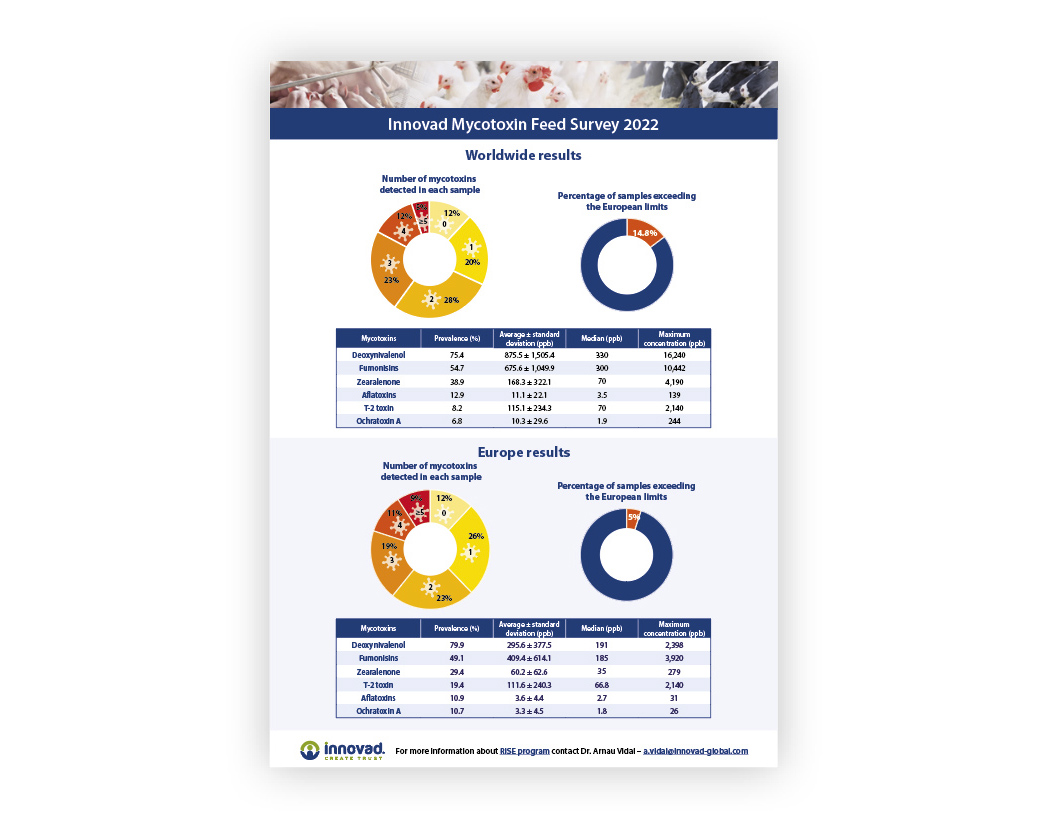
Get in touch with Dr. Arnau Vidal (a.vidal@innovad-global.com) to discover the mycotoxin risk detected in raw materials and feed specifically from your geographical area:
– Americas (North-America and Latin America),
– Europe (North/Center, East and South),
– Asia (North-East),
– MEA and Africa.
